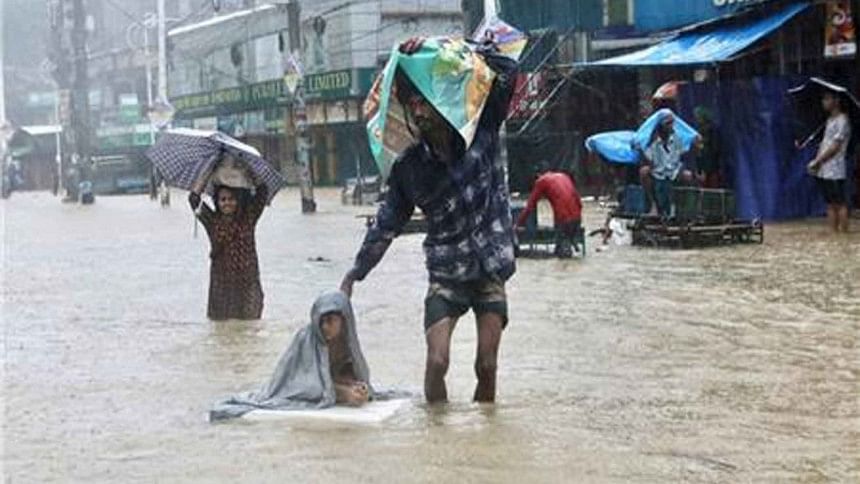The budget must provide for disaster management and recovery

Even after a lifetime of struggling to turn their lives around, a large number of vulnerable Bangladeshis face continuous climate-induced disasters, and each one brings them back to square one. Identifying the likelihood of disasters and carrying out precautionary responsibilities through intensification of early warning systems and anticipatory actions within areas prone to floods, cyclones, and other disasters can help bring down the damage and expenditure on consequent humanitarian response by at least 50 percent, according to research. This would also make the country more proactive towards shaping disaster management and humanitarian responses, rather than the less effective damage control methods that are currently in use.
Anticipation and risk-financing allow humanitarian services to prepare themselves better to cope with imminent disasters. A model needs to be put in place where risks are quantified in advance, costs pre-calculated, and activities pre-defined, all of it utilising scientific knowledge and data, and keeping in mind the local context. The existence of a pre-positioning fund and agreed-upon protocols can make it possible for first responders to act immediately. Bangladesh already has a detailed and rather advanced document called the "Standing Orders on Disaster" and is well on its way to finalising another document called the "National Adaptation Plan," both of which can support the proposed model. The national budget needs to reflect the existence of these documents and support the work that is going on for the country's climate vulnerable people.
One of the primary reasons people are hesitant about evacuating when floods hit the northern char areas or northeastern areas of the country is because they fear losing the livestock and other valuables they have so painstakingly bought and cared for over the years. Allocating safe spaces for the people and for their livestock will make the evacuation process much smoother. Spaces for congregational prayers, public places, or school playgrounds can be prepared in anticipation of these disasters. This hypothetical structure should be complete with shelter, water, sanitation, satellite clinics, an education centre, legal aid, community spaces, solar station, and a cattle shed along with insurance coverage. The authorities of sub-district and union councils should have detailed budget planning including funds, logistics, designated people, and transportation.
Millions of people have newly been plunged into poverty due to the Covid pandemic and runaway inflation. Attempts must be made to bring these people back into the economic mainstream and hand them back their power.
The UN Secretary-General Antonio Guterres once said that, for each dollar invested in climate resilient infrastructure, USD 6 is saved in adaptation costs. Similarly, a storm or heatwave warning just 24 hours ahead of time can help people mitigate damage by about 30 percent, a 2019 Global Commission on Adaptation (GCA) report said. GCA added, an expenditure of USD 800 million on early warning services in developing countries would potentially avert losses of USD 3 to 16 billion annually. Options that build people's resilience, like financial inclusion or social protection schemes, are good poverty reduction and alleviation policies for low- and middle-income nations.
Investments in the adaptation and mitigation of climate change are expected to translate into significant savings in the food and agricultural sectors. Initiatives such as mangrove plantations can save up to USD 80 billion in coastal flooding spending globally and protect some 18 million vulnerable populations around the world. Another USD 50 billion can be saved through non-market benefits. For Bangladesh especially, mangrove forests are not only a carbon sequestration method, but also an environmentally viable way to prevent coastal erosion. These forests also help in the generation of livelihood for the people and communities living around them. Government and non-government stakeholders need to work together to ensure more mangrove conservation and plantation initiatives, and the yearly budget should have a provision to create opportunities for these endeavours.
Water is a crucial element for survival and should be within arm's length of any Bangladeshi. In a study, it is mentioned that by the year 2030, the costs of securing water for our society would be a little over one percent of total GDP. This is a 29 percent rise in the cost of water per person per day, from 2015 till 2030. The economic benefit of investing in clean water and sanitisation is USD 6.80 per USD 1 invested.
A country's development should not simply be based on its economic development and its reserves. Access to water-sanitation, food security, education, health services, transportation, protection from the impacts of climate-induced disasters, gender equality, and rights-based provisions are also determining indicators for development.
Kazi Amdadul Hoque is senior director at Friendship and is working for strategic planning, climate action and development. Email: [email protected]

 For all latest news, follow The Daily Star's Google News channel.
For all latest news, follow The Daily Star's Google News channel. 



Comments